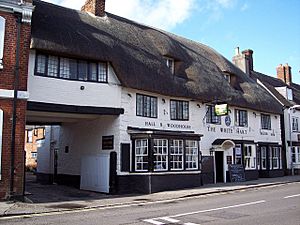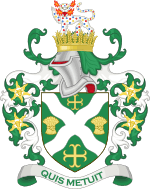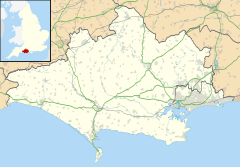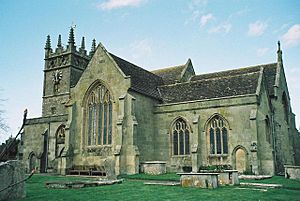Sturminster Newton facts for kids
Quick facts for kids Sturminster Newton |
|
|---|---|
 The White Hart, Market Cross |
|
 Coat of arms of Sturminster Newton Town Council |
|
| Population | Expression error: "String Module Error: Target string is empty" must be numeric () |
| OS grid reference | ST786140 |
| Unitary authority |
|
| Ceremonial county | |
| Region | |
| Country | England |
| Sovereign state | United Kingdom |
| Post town | STURMINSTER NEWTON |
| Postcode district | DT10 |
| Dialling code | 01258 |
| Police | Dorset |
| Fire | Dorset |
| Ambulance | South Western |
| EU Parliament | South West England |
| UK Parliament |
|
| Website | https://sturminster-newton.org.uk/ |
Sturminster Newton is a town in Dorset, England. It's located by the River Stour in the northern part of the county. The town is in the middle of the Blackmore Vale. This area is famous for dairy farming, which means producing milk and cheese. Sturminster Newton is often called 'the heart of the Blackmore Vale' because of this.
You'll find shops and schools in the town, including Sturminster Newton High School. There's also a special school and college for children with special educational needs. A market is held in the town every Monday. Long ago, one of England's biggest cattle markets was here, but it closed in 1998.
The town is also known for its links to famous writers like Thomas Hardy and William Barnes. It's also part of the traditional West Country Carnival celebrations.
Contents
A Look Back in Time: The History of Sturminster Newton
Sturminster Newton has a long history. It was first mentioned in an Anglo-Saxon document in 968. Back then, it was called Nywetone at Stoure. Later, in the Domesday Book of 1086, it was known as Newentone.
The name "Newton" means a new farm or estate. "Sturminster" refers to a church (a minster) by the River Stour. Originally, these names were for two separate settlements on different sides of the river. They were later combined to make sure people didn't confuse it with other places called Newton.
The Sturminster Newton Heritage Trust studies the town's history. They run the Sturminster Newton Museum. It's located in the Old Market Cross House in the town centre. The museum is open to visitors on certain days each week.
Sturminster Newton Castle
On a hill above the river bridge, you can find the ruins of Sturminster Newton Castle. This wasn't a strong defensive castle. Instead, it was a manor house, a large country house. This 14th-century building sits on a crescent-shaped mound. This mound might have been an Iron Age hillfort long ago.
The River Stour Bridge
Sturminster Newton is located at a historic fording point on the River Stour. A ford is a shallow place where you can cross a river. In the 1500s, a six-arch stone bridge was built to replace the ford. A long embankment was also built to cross the flood plain.
The bridge was made wider in 1820. A sign on the bridge from the 1800s warned that anyone who damaged it would be sent to Australia as a criminal.
Sturminster Newton Mill
The Sturminster Newton Heritage Trust also looks after the Sturminster Newton Mill. It's on the south side of the river. This mill has been around since at least 1016!
The mill was fixed up in 1980. Now, it's a working museum where visitors can see how a watermill operates. It's open on certain days from late March to late September. In 2020, the mill even started making flour again for sale.
Town Centre Buildings
The buildings in the town centre have different styles. Some are 17th and 18th-century thatched cottages. These have roofs made of straw. Others are Georgian stone buildings, and some are 19th-century brick buildings.
The market square and the parish church of St Mary are set back from the main road. The church was rebuilt in 1486 by the abbots of Glastonbury. It was changed a lot in the 1800s, but its carved wagon roof is still there.
The Railway and Creamery
Sturminster Newton railway station was part of the Somerset and Dorset Railway. This railway ran through the town from 1863 until 1966. It was taken apart as part of the Beeching Axe, a plan to close many railway lines.
The railway allowed milk trains to reach the local creamery. A creamery is a place where milk products are made. Local farmers started this creamery in 1913 to make cheddar cheese and pasteurised milk. The Milk Marketing Board took it over in 1937. Milk trains stopped in 1966 when the railway closed. The creamery kept working until 2000.
The train station and goods yard were taken down in the mid-1970s.
Thomas Hardy and the Cattle Market
The town is in the vale that writer Thomas Hardy called his fictional Vale of the little dairies. He wrote about it in his novel Tess of the d'Urbervilles. Sturminster used to have the biggest cattle market in Europe. It was near the town centre until it closed and was taken down in 1997.
How Sturminster Newton is Governed
Sturminster Newton is part of an electoral ward. This ward chooses one person to represent it on the Dorset Council. The town also has its own town council with 11 members.
For the UK parliament, Sturminster Newton is in the North Dorset parliamentary constituency. Currently, Simon Hoare from the Conservative party is the Member of Parliament for this area.
The Geography of Sturminster Newton
Sturminster Newton civil parish covers about 4,550 acres (1,840 hectares). The land here is between 45 and 119 metres (148 to 390 feet) above sea level. The highest parts are in the southeast.
The town is built on a meander of the River Stour. A meander is a bend in a river. The larger part of the town, called Sturminster, is on a low limestone ridge north of the river. This is where most of the shops and services are. The smaller part, Newton, is to the south, separated by a wide flood plain.
The ground in the parish is made up of different types of rock and soil. These include Oxford clay, Corallian limestone and sands, and Kimmeridge clay.
To the southeast of the town, you'll find Girdlers Coppice and Piddles Wood. These are areas of old woodland. They are special because they are designated as sites of special scientific interest. This means they are important for their plants and wildlife.
Population and People
The information below is for the Sturminster Newton civil parish. This area also includes the small settlements of Bagber, Broad Oak, and Puxey.
| Date | Population | Households |
|---|---|---|
| 2021 | 4,408 | 1,988 |
| 2011 | 4,292 | 1,910 |
| 2001 | 3,105 | 1,412 |
Religion and Culture
St Mary's Church is a Church of England parish church. It was rebuilt in 1486 by the abbots of Glastonbury. The church was changed a lot in the 1800s, but its carved wagon roof is still there. It's listed as a Grade I listed building by Historic England, meaning it's a very important historic building.
Sturminster Newton hosts the yearly UK Boogie Woogie Festival. In 2009, a famous boogie woogie musician, Little Willie Littlefield, performed there.
The Exchange is a community arts and conference centre. It's on Old Market Hill, built where the old cattle market used to be. Julian Fellowes officially opened it in December 2007. It's a place for music concerts, plays, and other events.
The Dorset Bach Cantata Club is based in Sturminster Newton. The town also has a football team, Sturminster Newton United F.C., founded in 1871. They play in the Dorset Premier Football League.
Media and News
Local news and TV shows for Sturminster Newton come from BBC West and ITV West Country. TV signals are received from the Mendip TV transmitter. You can also get BBC South and ITV Meridian from the Rowridge TV transmitter.
Local radio stations include BBC Radio Solent, Greatest Hits Radio South (which used to be called Vale FM), and Abbey104. Abbey104 is a community radio station that broadcasts from its studio in Sherborne.
The Dorset Echo is the local newspaper that covers news for the town.
Town Twinning
Sturminster Newton is twinned with another town. This means they have a special friendship and cultural exchange.
- Montebourg, Normandy, France
Famous People from Sturminster Newton
- William Barnes (1801–1886)
- Bryan "Badger" Goss (born 1940), a Motocross rider.
- Thomas Hardy (1840–1928) and his wife Emma lived in the town from 1876 to 1878. He wrote his 1878 novel The Return of the Native during this time.
- Keith Kyle (1925–2007), a writer, broadcaster, and historian, was born in the town.
- Eden Paul (1865–1944), a doctor, translator, and communist activist, was born in the town.
- Mark Price, Baron Price (born 1961), who was a UK Minister of Trade and Investment and a former managing director of Waitrose, lives in the town.
Images for kids
See also
 In Spanish: Sturminster Newton para niños
In Spanish: Sturminster Newton para niños








